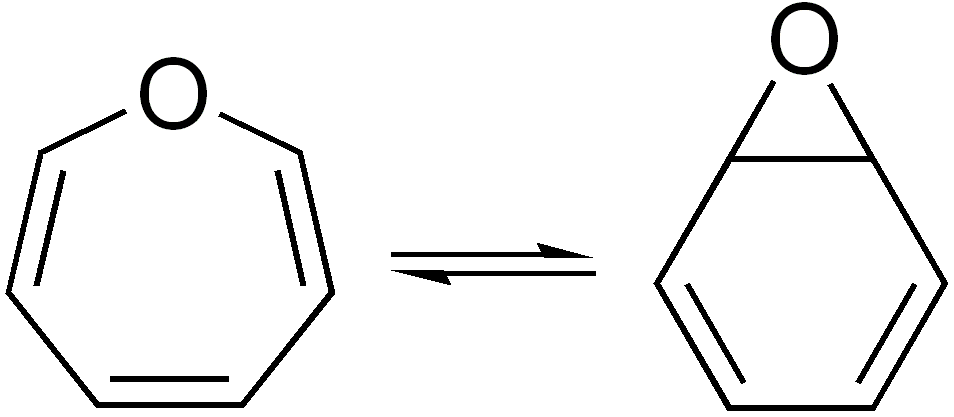Valence Isomerization on:
[Wikipedia]
[Google]
[Amazon]
In organic chemistry, two molecules are valence isomers when they are
Image:Benzene-2D-flat.png,
Image:Cyclooctatetraen.svg, Cyclooctatetraene (COT)
Image:Barrelene structure.png, Barrelene
Image:Cuban.svg, Cubane
Image:Cuneane.png,
Image:Naphthalene-2D-Skeletal.svg,

constitutional isomer
In chemistry, a structural isomer (or constitutional isomer in the IUPAC nomenclature) of a chemical compound, compound is another compound whose molecule has the same number of atoms of each element, but with logically distinct chemical bond, b ...
s that can interconvert through pericyclic reaction
In organic chemistry, a pericyclic reaction is the type of organic reaction wherein the transition state of the molecule has a cyclic geometry, the reaction progresses in a concerted fashion, and the bond orbitals involved in the reaction overlap ...
s.
Benzene
There are many valence isomers one can draw for the C6H6 formulabenzene
Benzene is an organic chemical compound with the molecular formula C6H6. The benzene molecule is composed of six carbon atoms joined in a planar ring with one hydrogen atom attached to each. Because it contains only carbon and hydrogen atoms, ...
. Some were originally proposed for benzene itself before the actual structure of benzene was known. Others were later synthesized in lab. Some have been observed to isomerize to benzene, whereas others tend to undergo other reactions instead, or isomerize by ways other than pericyclic reactions.
Benzene
Benzene is an organic chemical compound with the molecular formula C6H6. The benzene molecule is composed of six carbon atoms joined in a planar ring with one hydrogen atom attached to each. Because it contains only carbon and hydrogen atoms, ...
Image:Historic Benzene Formulae Dewar(1867) V.1.svg, Dewar benzene
Image:Prisman2.svg, Prismane
Prismane or 'Ladenburg benzene' is a polycyclic hydrocarbon with the formula C6H6. It is an isomer of benzene, specifically a valence isomer. Prismane is far less stable than benzene. The carbon (and hydrogen) atoms of the prismane molecule are a ...
Image:Benzvalene.png, Benzvalene
Benzvalene is an organic compound and one of several isomers of benzene. It was first synthesized in 1971 by Thomas J. Katz et al.
The 1971 synthesis consisted of treating cyclopentadiene with methyllithium in dimethyl ether and then with dichlor ...
Image:Bicycloprop-2-enyl.svg, Bicyclopropenyl
Bicyclopropenyl (bicycloprop-2-enyl, C6H6) is an organic compound and one of several valence isomers of benzene. The molecule can be described as two coupled cyclopropene units. The positions of the alkene groups can vary and therefore two other i ...
Cyclooctatetraene
The valence isomers are not restricted to isomers of benzene. Valence isomers are also seen in the series (CH)8. Due to the larger number of units, the number of possible valence isomers is also greater and at least 21:Cuneane
Cuneane (C8H8, pentacyclo .3.0.02,4.03,7.06,8ctane) is a saturated hydrocarbon. Its name is derived from the Latin ''cuneus'', meaning a wedge. Cuneane may be produced from cubane by metal-ion-catalyzed σ-bond rearrangement. Similar reactions ar ...
Image:Semibullvalene.svg, Semibullvalene
Image:1,5-dihydropentalene.png, 1,5-dihydropentalene
Image:2a,2b,4a,4b-tetrahydrocyclopropa cd pentalene.png, 2a,2b,4a,4b-Tetrahydrocyclopropa dentalene
Image:Bicyclo420octa247triene.svg, Bicyclo .2.0cta-2,4,7-triene. Tautomer
Tautomers () are structural isomers (constitutional isomers) of chemical compounds that readily interconvert.
The chemical reaction interconverting the two is called tautomerization. This conversion commonly results from the relocation of a hydr ...
with COT by thermal 6e process or photochemical 4e process
Image:Tricyclo33006octa38diene.svg, Tricyclo ,3,0,02,6cta-3,8-diene. Isomerises to semibullvalene at room temperature, stable at −60 °C
Image:Cyclobutadiene dimer cis trans.svg, Tricyclo ,2,0,02,5cta-3,7-diene. The dimer of cyclobutadiene occurs as a cis isomer and a trans isomer. Both isomers convert to COT (symmetry forbidden hence stable) with a half-life of 20 minutes at 140 °C
Image:Tetracyclooctaene.svg, Tetracyclo ,3,0,02,4,03,6octa-7-ene is only known as its 4-carbomethoxy derivative.
Image:Tetracyclooct-7-ene.svg, Tetracyclo ,2,0,02,4,03,5octa-7-ene has been prepared from benzvalene and isomerises to COT
Image:Octabisvalene.svg, Pentacyclo .1.0.02,4. 03,5.06,8ctane (octabisvalene) is the third saturated valence isomer. The (Z)-3,7-phenylsulfonyl derivative is stable up to 200 °C.
Image:Octavalene.svg, Tricyclo .1.0.02,8cta-3,5-diene (octavalene) was reported synthesised from homobenzvalene and converts to COT at 50 °C ''Electronic structure of octavalene. Photoelectron spectroscopic investigations'' Rolf Gleiter, Peter Bischof, Manfred Christl J. Org. Chem.
''The Journal of Organic Chemistry'', colloquially known as ''JOC'', is a peer-reviewed scientific journal for original contributions of fundamental research in all branches of theory and practice in organic and bioorganic chemistry. It is publ ...
, 1986, 51 (15), pp 2895–2898
Naphthalene and azulene
Perhaps no pair of valence isomers differ more strongly in appearance than colourless naphthalene and the intensely violet azulene.Naphthalene
Naphthalene is an organic compound with formula . It is the simplest polycyclic aromatic hydrocarbon, and is a white crystalline solid with a characteristic odor that is detectable at concentrations as low as 0.08 ppm by mass. As an aromati ...
Image:Azulene-numbers.png, Azulene
Benzene oxide and oxepin

References
External links
*{{Commonscatinline Isomerism